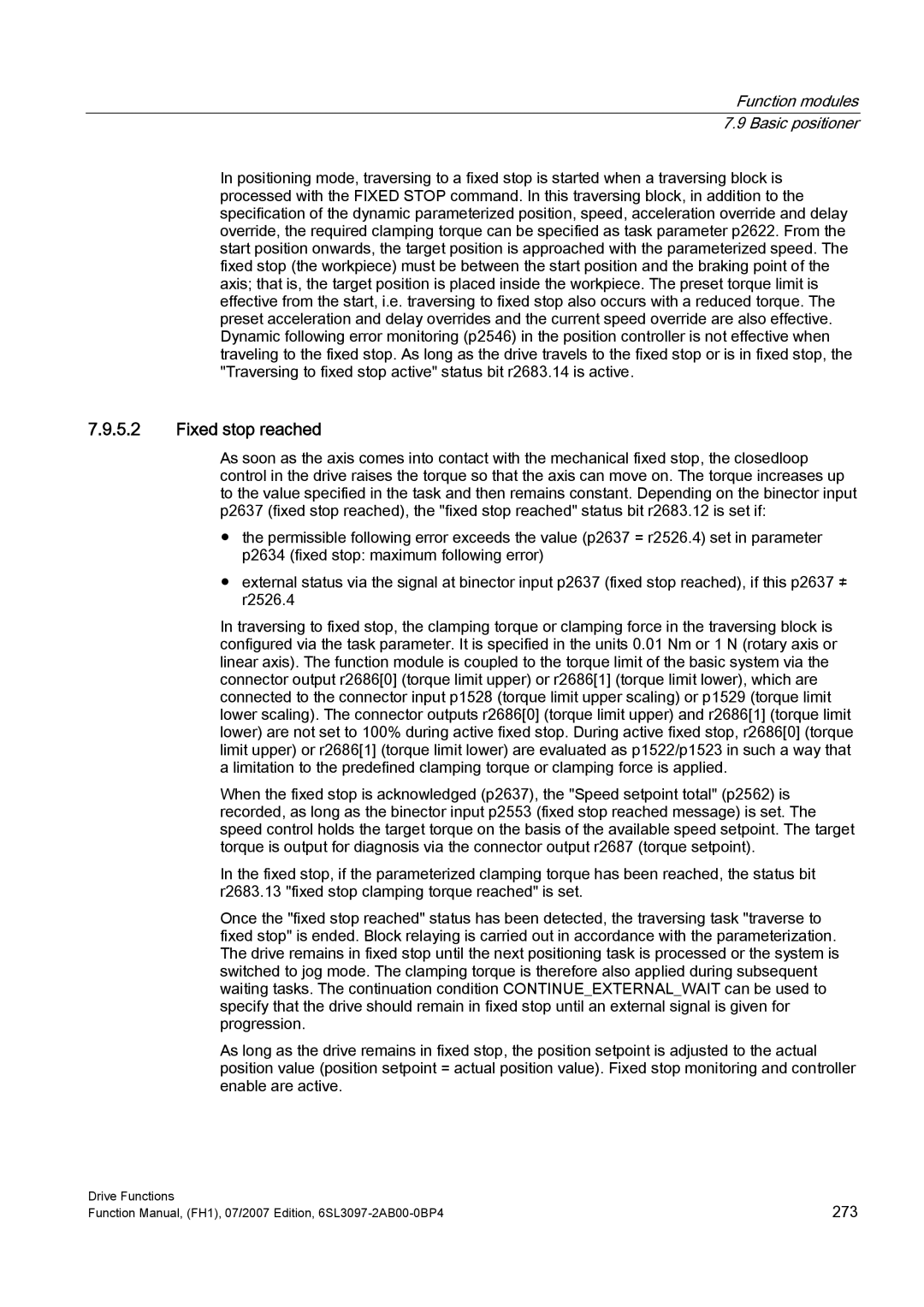Function modules 7.9 Basic positioner
In positioning mode, traversing to a fixed stop is started when a traversing block is processed with the FIXED STOP command. In this traversing block, in addition to the specification of the dynamic parameterized position, speed, acceleration override and delay override, the required clamping torque can be specified as task parameter p2622. From the start position onwards, the target position is approached with the parameterized speed. The fixed stop (the workpiece) must be between the start position and the braking point of the axis; that is, the target position is placed inside the workpiece. The preset torque limit is effective from the start, i.e. traversing to fixed stop also occurs with a reduced torque. The preset acceleration and delay overrides and the current speed override are also effective. Dynamic following error monitoring (p2546) in the position controller is not effective when traveling to the fixed stop. As long as the drive travels to the fixed stop or is in fixed stop, the "Traversing to fixed stop active" status bit r2683.14 is active.
7.9.5.2Fixed stop reached
As soon as the axis comes into contact with the mechanical fixed stop, the closedloop control in the drive raises the torque so that the axis can move on. The torque increases up to the value specified in the task and then remains constant. Depending on the binector input
p2637 (fixed stop reached), the "fixed stop reached" status bit r2683.12 is set if:
●the permissible following error exceeds the value (p2637 = r2526.4) set in parameter p2634 (fixed stop: maximum following error)
●external status via the signal at binector input p2637 (fixed stop reached), if this p2637 ≠ r2526.4
In traversing to fixed stop, the clamping torque or clamping force in the traversing block is configured via the task parameter. It is specified in the units 0.01 Nm or 1 N (rotary axis or linear axis). The function module is coupled to the torque limit of the basic system via the connector output r2686[0] (torque limit upper) or r2686[1] (torque limit lower), which are connected to the connector input p1528 (torque limit upper scaling) or p1529 (torque limit lower scaling). The connector outputs r2686[0] (torque limit upper) and r2686[1] (torque limit lower) are not set to 100% during active fixed stop. During active fixed stop, r2686[0] (torque limit upper) or r2686[1] (torque limit lower) are evaluated as p1522/p1523 in such a way that a limitation to the predefined clamping torque or clamping force is applied.
When the fixed stop is acknowledged (p2637), the "Speed setpoint total" (p2562) is recorded, as long as the binector input p2553 (fixed stop reached message) is set. The speed control holds the target torque on the basis of the available speed setpoint. The target torque is output for diagnosis via the connector output r2687 (torque setpoint).
In the fixed stop, if the parameterized clamping torque has been reached, the status bit r2683.13 "fixed stop clamping torque reached" is set.
Once the "fixed stop reached" status has been detected, the traversing task "traverse to fixed stop" is ended. Block relaying is carried out in accordance with the parameterization. The drive remains in fixed stop until the next positioning task is processed or the system is switched to jog mode. The clamping torque is therefore also applied during subsequent waiting tasks. The continuation condition CONTINUE_EXTERNAL_WAIT can be used to specify that the drive should remain in fixed stop until an external signal is given for progression.
As long as the drive remains in fixed stop, the position setpoint is adjusted to the actual position value (position setpoint = actual position value). Fixed stop monitoring and controller enable are active.
Drive Functions | 273 |
Function Manual, (FH1), 07/2007 Edition, |
